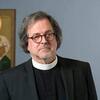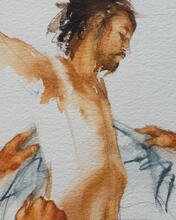Christian Forgiveness: The Case of Judas
(This article is adapted from the chapter “Judas” in Andrew McGowan’s new book, Seven Last Words: Cross and Creation, published by Cascade Books, an imprint of Wipf and Stock Publishers. Used here by permission of Wipf and Stock.)
“Surely not I, Rabbi?” (Matt 26:25)
Despite the Savior of the world setting an example with his own first word from the Cross—“Father, forgive them”—Christians themselves are not so free in forgiving. Forgiveness is hard, for one thing. It certainly sounds like a good idea; yet the reality of forgiveness has to be tested concretely, rather than as mere principle.
In Matthew’s Gospel, Peter probes this question revealingly, asking how many times he should forgive a brother, and apparently thinking seven was a pretty generous number that would earn him some credit (18:21-2). Not so, it turns out. And this impulse to constrain the fearful possibility of forgiveness on the loose continues.
The historic attribution of guilt to the Jewish people was the great and fatal historic exception of Christian ethics.
We can see all around us today, and across history, evidence of Christians personally and institutionally trying to plug the leaks in this awkward boat of radical forgiveness to which they have been consigned, testing the conditions that can or must be attached to forgiveness, the limits that must be established, and so on. And often it’s not Peter’s quantitative test they are trying to cope with, it’s the qualitative one: how bad does something have to be, before I actually don’t have to forgive it?
The Anti-Semitic Exception
The acid test case for thinking about forgiveness must be Judas, who got us into this mess in the first place. What will we say of him? Jesus, in the text we have received as the first word from the Cross, solves the problem fairly clearly, however hesitant we may be to accept it: “Father, forgive them” is clearly a reference to those responsible for his suffering and death in particular. No, there isn’t really anything worse to forgive than this. It’s not that we all have the capacity to emulate Jesus here or otherwise, of course. And even Jesus wasn’t condoning torture and killing, which can never be condoned whoever is doing the suffering. He was pointing past them to the fact that it is always people, real human beings, who do the worst imaginable things. The suffering they cause will end, but the people themselves remain available for us to forgive, or not, afterwards.
The Church has of course set a poor example by denying the meaning of the saying in a quite specific way. The historic attribution of guilt to the Jewish people was the great and fatal historic exception of Christian ethics, the avoidance of the obvious concrete challenge of forgiveness in favor of the abstract principle, and hence applying it selectively in ways that suited our preconceptions.
The anti-Semitic exception to any expectation of forgiveness was even facilitated by the name of “Judas,” or Judah, who is indeed, by name at least, the paradigmatic Judean or Jew. The controversy about whether Jesus’ saying about forgiveness from the Cross could even be accepted as part of the authentic text of Luke was closely related to whether or not early scribes and readers thought it referred to Jews (“surely not”) or Romans (“what a relief”).
“Whom Shall I Forgive?”
More recently, scholarship has shifted the gaze of historic blame, correctly pointing to the fact that Roman law and authority was certainly the real cause of Jesus’ death, and that “Jewish” complicity was merely that of certain elites. Even these accurate observations however seem to be fodder for the old wrong question, “whom shall I forgive?” Christians are now more likely—although not quite likely enough—to understand that a blood libel against the Jews is both historically false and theologically repugnant, but then the searchlight of blame seems to be re-adjusted rather than turned off. Arguing over just who it is that should be blamed, and who can thus be exempted from the forgiveness at the heart of the gospel, is rather to miss the point, but of course we often do that—hence a cross in the first place.
Judas remains in the frame in a unique way however, despite the lessening of the anti-Semitic trope. While some elite locals seem to have been more actively malicious towards Jesus, and Pilate far more powerful in sealing his fate, Judas has the unique taint of being one of those close to Jesus, a true believer, whose failure constitutes a unique threat. The traitor is a greater threat than the enemy.
The Salvation of Judas
Nevertheless, many have wondered from early times about the salvation of Judas. While medieval tradition has him as the epitome of evil, his role is presented in scripture itself as more a necessary but tragic one, the result of external evil and not merely of his own choices.[1] Ancient Christian writers were thus at least somewhat sympathetic to his plight. Origen of Alexandria perceived there was a “mystery” there in Judas, something not readily reduced to jeers and accusations.[2] Origen even believed Judas experienced a genuine form of repentance after the fateful events—but that it was not quite enough.
Facing Our Own Forgiveness
The obvious and unhappy tendency to cast judgement on others, or to allow it to be cast, often says more about us and what we are hiding, even from ourselves. So too the problem with Judas may not simply be the enormity of his crime but, just as Origen thought, the limits to his own capacity to accept forgiveness. While unthinking moralism and rousing condemnation of the “sinners” (whoever they may be at a given time) is one side of Christians’ incapacity to grasp the meaning of the Cross, there is another aspect that initially seems like the opposite, but probably isn’t. The most viciously judgmental, you may have noted, often use their high-minded condemnation to draw a veil over their own problems, even to themselves. This phenomenon, I suspect, lies underneath another famous but contested saying of Jesus about sin and forgiveness, namely that “the one without sin [should] cast the first stone” (John 8:7). This again seems to have given some Christian scribes the idea that Jesus was lowering the bar too far, and the story in which it was embedded thus travelled uncertainly in Gospel manuscripts.[3]
Judas was not at the Cross. One of the few sayings attributed to him however comes from just prior to these events, and seems to echo around when Jesus speaks his first word. When just hours before Jesus predicted his betrayal, Judas said “surely, Rabbi, not me?” Judas’ incredulity, whether feigned or real at that point, seems to continue from here to his end. He moves from being unable to imagine the betrayal prediction as about him, to being unable to imagine the offer of forgiveness as for him. Is this not the case with us too, whether about forgiveness for ourselves or for others? The sheer unlikelihood of forgiveness, its being spoken from the Cross under the most impossible of circumstances, evokes our deepest objections not only to Judas’ forgiveness, but to our own. The reconstructed conversation between Jesus and Judas is thus one we may all have to acknowledge:
“Father, forgive them.” “Surely, not I?”
Andrew McGowan is Dean and President of Berkeley Divinity School at Yale, where he is also McFaddin Professor of Anglican Studies and Pastoral Theology. An Anglican priest and historian of early Christian communities, he is the author of Ancient Christian Worship (Baker Academic, 2014) and editor of the Journal of Anglican Studies for Cambridge University Press. He blogs at Saint Ronan Street Diary.
[1] See further Felicity Harley, “Hanging by a Thread: The Death of Judas in Early Christian Art,” in The Eloquence of Art: Essays in Honour of Henry Maguire, edited by Andrea Olsen Lam and Rossitza Schroeder (Routledge, 2020), pp. 115–30.
[2] See Origen, Commentary on John 32.21
[3] See Jennifer Knust and Tommy Wasserman, “Earth Accuses Earth: Tracing What Jesus Wrote on the Ground,” The Harvard Theological Review 103, no. 4 (2010), pp. 407–46.

